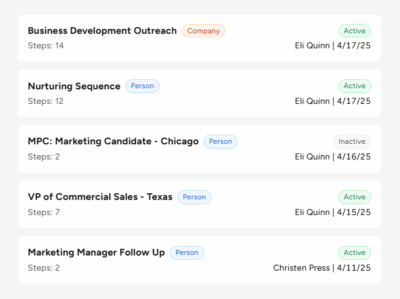When it comes to enjoying success with posting jobs on the Internet, there are a lot of steps involved. Among them:
- Actually securing a job order from a client
- Figuring out how to write a job description that includes all relevant job requirements
- Getting that job posting in front of qualified candidates
- Convincing qualified candidates to nominate themselves for the position based on the posting
That last step is the most important one. Even if you nail the other three steps, if you fail on the fourth one, then the whole thing is a failure. Essentially, figuring out how to close a candidate starts long before you even meet them!
It’s like the old riddle: “If a tree falls in the woods and nobody hears it, did it really fall?” So we have this question:
“If you post a job to the Internet and nobody responds, did you really post it?”
For all intents and purposes, the answer to that question is “No.” How do recruiters find candidates if the job ads are putting them to sleep? You can post jobs all day long, but if nobody responds to the postings, then you’re just wasting your time.
And of course, you don’t want just anybody responding to your postings. You want high-quality, place-able candidates responding, so that you can present them to your clients and eventually place them. Just because you post a job does not mean that they’re going to automatically be interested. No, your posting will have to recruit them from the get-go.
So the big questions is . . . how do you do that? What is included in a job description that will motivate the best candidates to take swift action?
How to create a job description for your job posting
Well, there are a number of things to consider while writing job descriptions. We’ve addressed those things in this blog post, so compare your job descriptions to the criteria listed below.
Size or length of the job ad
The rule of thumb is that you don’t want your posting to be two big. Or too small. You want it to be, you guessed it, just right. What does that mean? Creating job descriptions over 1,000 words is probably iffy. You’ll want your job ad to stay just under that. However, if your postings start clocking in around 500 words, that’s too short. It’s tough to convey that this is the “greatest job in the history of jobs” in just 500 words.
Job title
Be as specific as you can. Once again, you want to strike a balance. While being specific, also be brief. You don’t want a job title that’s 10 words long. On the other hand, you don’t want one that’s a single word. (Unless, of course, that word is both 100% accurate and specific).
Think of the ideal candidate. On what job title might they be searching if they wanted to pursue a new employment opportunity? Putting yourself in the shoes of the candidates you want to place is the proper frame of mind for writing a good job description for your posting.
Summary of the job description
This if your first opportunity to really grab the readers. Basically, you want to convince them to read more and not bounce off the page. Sure, the summary has to contain the overall expectations and job requirements for the position, plus an overview of the company. But do NOT make that dry reading! Writing effective job descriptions requires that you focus on what is unique or special about the opportunity and the organization. Play this up as much as possible to compel candidates to consider the job.
Also disclose the location within the summary, specifically the city and state. Location is a big consideration for candidates, and relocation is a big consideration for both them and your clients. And you might want to mention whatever is unique or special about the location, as well.
Job requirements
Okay, let’s talk priorities here. What are the job requirements that your client can’t live without? Listing every little thing you could possibly want will make the posting too long. What does your client want MOST in a candidate? Those things should be given priority while creating a job description for the job posting. Of course, there are things that should absolutely be included:
- Level of education
- Job experience in applicable areas
- Certifications or training/educational designations
If there’s room, throw in some “soft skills” if they’re integral to the position, and even follow-up with a soft skills questionnaire. Remember that while you’re trying to attract the right candidates, you also want to screen out ones that would not be a good fit. The job requirements can act as a preliminary job-fit test that is extremely scalable.
Duties and responsibilities
Okay, there are three parts to this section:
#1—Core duties and responsibilities
For some positions, there is a set standard of duties across the industry. Make that your starting point. But then consider this: what about this position within the organization is different from other positions? Chances are good that there’s something. Once again, different can be good. Different is unique, and that’s what people are seeking in a new position: something different than what they already have.
#2—Day-to-day activities
Now drill down into the nitty-gritty. Paint a picture of what the candidate will do on a daily basis. This includes the work environment, projects, deadlines, time tables, and the specific activities and tasks they’ll be expected to complete. Once again, strive to write them in a way that makes them sound attractive, not tedious.
#3—The bigger picture
Now come back up from the nitty-gritty and go big. Candidates, especially top candidates, want to know how they fit into the overall mechanics of the organization. They also want to know their role regarding the vision that the company has for the future. How do they fit into that role? How important is their role? What kind of impact could they make? While considering how to write a job description, always keep the bigger picture within view.
The “sizzle”
Above all else, you must remember to sell both the opportunity and the employer. Don’t just recite bland, dry facts and job requirements. Nobody likes bland or dry. But everybody likes steak, and steaks sizzle, so pour on the “sizzle.” Think about the job from the point of view of the candidate. Does it sound exciting? Does it sound interesting at all? If it doesn’t sound interesting to you, then it probably will not be interesting to them.
Writing a blah and uninspiring job posting is like trying to fish by just throwing a hook into the water without bait on it. No fish is going to hook itself for no reason. No candidate—especially a top candidate—is going to nominate themselves for a job for no reason. There has to be a reason, and more specifically, there has to be a good reason for them to do that.
It’s your job to give them that good reason. While learning how to write a good job description, you’ve got to go beyond a standard list of requirements. Write a thorough, concise, and engaging job description that makes the opportunity sound like a great career move and the employer sound fun and exciting. Make the investment of time, energy, and effort necessary. Writing a great job description will be a valuable addition to your portfolio of recruitment skills.
Because the final step in job posting success is the hiring of the right candidate.








